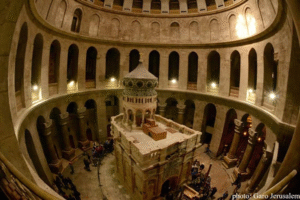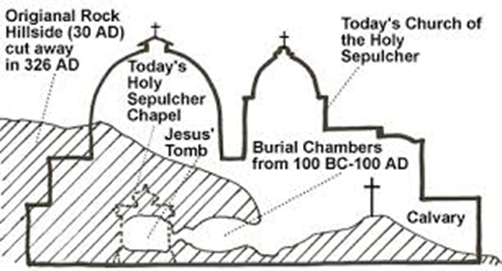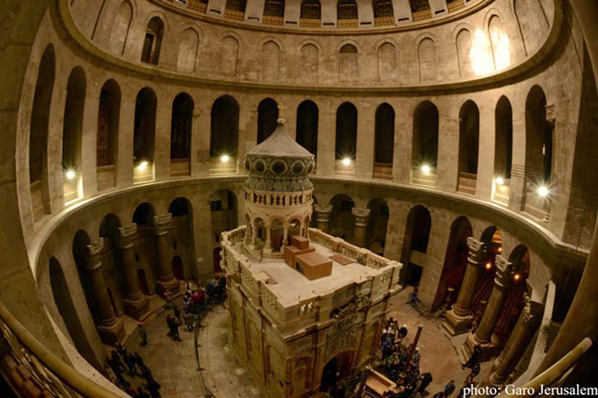Introduction
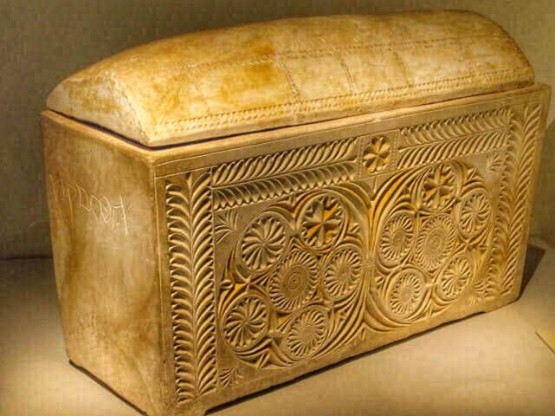 In and around Jerusalem during the time of Jesus the dead were laid on stone shelves which were carved into the limestone hills surrounding the city. The entrance was normally covered by a large wheel shaped rock running along a grove to prevent grave robbers from entering. After the body has laid for twelve months, due to the local climate and the alkalinity of the limestone, only bones remain. These were collected and placed into a stone box called an ossuary The high priest Caiaphas’ ossuary is shown.
In and around Jerusalem during the time of Jesus the dead were laid on stone shelves which were carved into the limestone hills surrounding the city. The entrance was normally covered by a large wheel shaped rock running along a grove to prevent grave robbers from entering. After the body has laid for twelve months, due to the local climate and the alkalinity of the limestone, only bones remain. These were collected and placed into a stone box called an ossuary The high priest Caiaphas’ ossuary is shown.
What the Bible tells us about Jesus’ burial
Matthew 27:57-61.
When it was evening, there came a rich man from Arimathea, named Joseph, who also was a disciple of Jesus. He went to Pilate and asked for the body of Jesus. Then Pilate ordered it to be given to him. And Joseph took the body and wrapped it in a clean linen shroud and clad it in his own new tomb, which he had cut in the rock. And he rolled a great stone to the entrance of the tomb and went away. Mary Magdalene and the other Mary were there, sitting opposite the tomb.
Mark 15:42-47 and Luke 23:50-55 states similarly to Matthew. John 19:38-42 states the same but adds two more pieces of information; the tomb was at the place where Jesus was crucified and there was a garden there as well.
Confirmation of the garden comes from Mary Magdalene who suppose she was talking to a “gardener” when He was the risen Christ. (John 20:15)
Hebrews 13:12
And so Jesus also suffered outside the city gate to make the people holy through his own blood.
The writer of Hebrews links Christ’s death and burial to the Mosaic law anything unclean must be outside the camp (Leviticus 13:46, Numbers 5:2-3 and Deuteronomy 23:14). He was unclean of course because He was carrying the sins of the world with Him. 1 Peter 2:24 states; He himself bore our sins in his body on the tree, that we might die to sin and live to righteousness; by his wounds you have been healed.
More biblical information
Matthew 27:33, Mark 15:22 and John 19:17. Used the word Golgotha to describe the place where Jesus was crucified.
For example, Matthew 27:33-34
They came to a place called Golgotha (which means “the place of the skull”). There they offered Jesus wine to drink, mixed with gall; but after tasting it, he refused to drink it.
Luke 23:33 refers to the “Place of the Skull.” by its Greek name Kranion G3191, which Jerome’s Latin Vulgate gives it the Latin name calvatia and thus the 1611 King James Bible anglicised it to Calvary.
So, the names Golgotha and Calvery both refer to the same place where Jesus was crucified.
In summary, the tomb where the body of Jesus was laid, was owned by Joseph of Arimathea, it was a new tomb freshly cut out of stone, it was near where Jesus was crucified the place was called Golgotha or Calvary which means skull it was in a garden, and it had to be outside the city wall.
Where is that place? There are two possibilities: The church of the Holy Sepulchre and the Garden tomb.
The Church of the Holy Sepulchre
Site history[1]
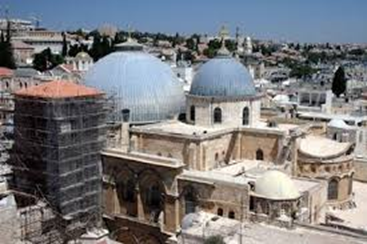 There was a road that passed by the stone quarry, serving as a route for travellers entering and leaving Jerusalem. Because the quarry had fallen out of use many years before Christ, it gradually developed into a garden, with a nearby cistern and pool of water. Some of the rock was left, and the Romans crucified people upon it. It was an ideal place because it was just outside the city and located on a well-travelled road (Matthew 27:39). The Romans crucified people in the most visible places possible so all would learn what would happen to them if they disobeyed Roman laws. There were also tombs in the rock faces that were used for burials.
There was a road that passed by the stone quarry, serving as a route for travellers entering and leaving Jerusalem. Because the quarry had fallen out of use many years before Christ, it gradually developed into a garden, with a nearby cistern and pool of water. Some of the rock was left, and the Romans crucified people upon it. It was an ideal place because it was just outside the city and located on a well-travelled road (Matthew 27:39). The Romans crucified people in the most visible places possible so all would learn what would happen to them if they disobeyed Roman laws. There were also tombs in the rock faces that were used for burials.
After the siege of Jerusalem in AD 70 during the First Jewish–Roman War, Jerusalem had been reduced to ruins. In AD 130, the Roman emperor Hadrian began the building of a Roman colony, the new city of Aelia Capitolina, on the site. About AD 135, he ordered that a cave containing a rock-cut tomb be filled in to make a flat foundation for a temple dedicated to Jupiter or Venus. The temple remained until the early fourth century.
Constantine and Macarius: context for the first sanctuary
After seeing a vision of a cross in the sky in 312, Constantine the Great began to favour Christianity and signed the Edict of Milan legalizing Christianity. About 326, Constantine ordered that the temple to Jupiter or Venus be replaced by a church. After the temple was torn down and its ruins removed, the soil from the cave was removed also, revealing a rock-cut tomb that Macarius, the bishop of Jerusalem, identified as the burial site of Jesus. A shrine was built on the site of the tomb enclosing the rock tomb walls within its own. And became known as the Church of the Holy Sepulchre. The church was consecrated on 13 September 335.
Damage, protection, and destruction
The Constantinian sanctuary in Jerusalem was destroyed by a fire in May of 614. In 630, the Emperor Heraclius rebuilt the church after recapturing the city.
After Jerusalem came under Islamic rule, it remained a Christian church, with the early Muslim rulers protecting the city’s Christian sites, prohibiting their destruction or use as living quarters.
The building suffered severe damage from an earthquake in 746.
Early in the ninth century, another earthquake damaged the dome of the Anastasis. The damage was repaired in 810 by Patriarch Thomas I. In 841, the church suffered a fire. In 935, the Christians prevented the construction of a Muslim Mosque adjacent to the Church. In 938, a new fire damaged the inside of the basilica and came close to the rotunda. In 966, due to a defeat of Muslim armies in the region of Syria, a riot broke out, which was followed by reprisals. The basilica was burned again.
On 18 October 1009, Fatimid caliph al-Hakim bi-Amr Allah ordered the complete destruction of the church as part of a more general campaign against Christian places of worship in Palestine and Egypt. The damage from this exercise was extensive, with few parts of the early church remaining, and the roof of the rock-cut tomb damaged. The tomb itself was almost destroyed, with only portions of the northern wall containing the burial bench and the southern wall surviving. Control of Jerusalem, and thereby the Church of the Holy Sepulchre, continued to change hands several times between the Fatimids and the Seljuk Turks until the Crusaders’ arrival in 1099.
The Crusaders began to refurnish the church in Romanesque style and added a bell tower. These renovations unified the small chapels on the site and were completed during the reign of Queen Melisende in 1149, placing both holy places, the site of Jesus’ crucifixion and His burial, under one roof for the first time. The church was lost to Saladin, along with the rest of the city, in 1187, although the treaty established after the Third Crusade allowed Christian pilgrims to visit the site. Both city and church were captured by the Khwarezmians in 1244.
The Franciscan friars renovated the church in 1555, as it had been neglected despite increased numbers of pilgrims. The Franciscans rebuilt the Aedicule, extending the structure to create an antechamber. A marble shrine commissioned by Friar Boniface of Ragusa was placed to envelop the remains of Christ’s tomb, probably to prevent pilgrims from touching the original rock or taking small pieces as souvenirs. A marble slab was placed over the limestone burial shelf where Jesus’s body is believed to have lain.
A fire severely damaged the structure again in 1808, causing the dome of the rotunda to collapse and smashing the Aedicule’s exterior decoration. The rotunda and the Aedicule’s exterior were rebuilt in 1809–10 in the contemporary Ottoman Baroque style.
Another decree in 1853 from the sultan solidified the existing territorial division among the communities and he made arrangements for it to “remain in their present state”, requiring consensus to make even minor changes. The dome was restored using iron by Catholics, Greeks, and Turks in 1868.
Reinforcing work on the Aedicule
By the time of the British Mandate for Palestine following the end of World War I, the cladding of red limestone applied to the Aedicule since at least 1555 had deteriorated badly and was detaching from the underlying structure; from 1947 until restoration work in 2016–17, it was held in place with an exterior scaffolding of iron girders installed by the British authorities.
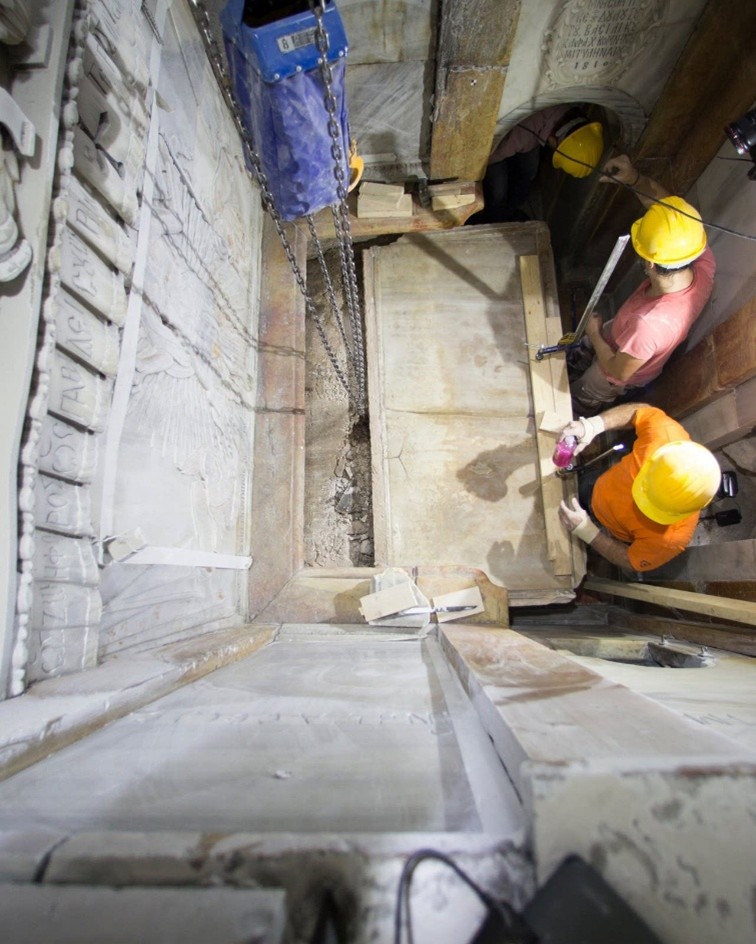 The rotunda, pictured, was constructed by Constantine in AD 380 is in the centre of the church of the Holy Sepulchre. It is the larger of the church’s two domes. In the centre of the rotunda is a small chapel called the Kouvouklion in Greek or the Aedicula in Latin. It encloses Jesus’ tomb. The aedicule is central in the church, as shown.
The rotunda, pictured, was constructed by Constantine in AD 380 is in the centre of the church of the Holy Sepulchre. It is the larger of the church’s two domes. In the centre of the rotunda is a small chapel called the Kouvouklion in Greek or the Aedicula in Latin. It encloses Jesus’ tomb. The aedicule is central in the church, as shown.
A project to restored its structural integrity involved a rare collaboration between the three main Christian communities: Greek Orthodox, Armenian, and Franciscan. This was followed by a separate project that began in March 2022 with the restoration of the floors and underground areas of the wider rotunda.
Inside the Aedicula are two chambers: the Chapel of the Angel, and the tomb chamber itself, where a marble slab covers the rock bench where Jesus’s body was believed to have lain and has been covered by marble cladding since at least AD 1555. In this project workmen removed the marble slab which covered the limestone bed which is believed to be where Joseph of Arimathea and Nicodemus laid the body of Jesus. This removal is shown in the picture.
The Garden Tomb
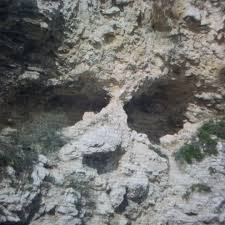 In 1
In 1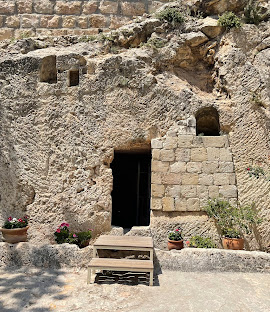 867 a tomb was discovered by a Greek family who owned the land and were excavating for a cistern. In 1883: British General Charles Gordon promoted the site as a potential location for Jesus’s crucifixion and burial, inspired by the nearby rock resembling a skull and the tomb’s location outside the city walls. Gordon’s identification gained traction, particularly among Protestant Christians who found the site’s garden, a peaceful setting to be a more fitting alternative to the traditional Church of the Holy Sepulchre.
867 a tomb was discovered by a Greek family who owned the land and were excavating for a cistern. In 1883: British General Charles Gordon promoted the site as a potential location for Jesus’s crucifixion and burial, inspired by the nearby rock resembling a skull and the tomb’s location outside the city walls. Gordon’s identification gained traction, particularly among Protestant Christians who found the site’s garden, a peaceful setting to be a more fitting alternative to the traditional Church of the Holy Sepulchre.
Prior to the buildup of modern eastern Jerusalem, and in particular the bus station that was erected there by the Jordanians in the 1950s, the skull feature was much more visible. Photographs (see opposite) from the late 1800s and early 1900s, when ground level of the area in front of the stone formation was lower and void of buildings, show a stone image that is skull-like from jaw to forehead—a grim cranial visage staring off to the south. Even today, when viewed from the top of the Old City wall, or even from the parking lot of the bus station, the skull-like appearance of the escarpment is easily discernible from below the nose bridge to the top of the brow.
The only basis for believing the Garden Tomb was the actual tomb of Jesus is the fact the rock face in which it was carved could resemble a skull and that it is presently in a garden. Opposing this identification is the fact that the early church never recognised it as the site of the original tomb as shown by the lack of the erection of any chapel, shrine, monument, or any other structural identification.
An ancient garden found
The following report written by Dario Radley, appeared in Archaeology News Online Magazine, April 6, 2025.
Archaeologists digging beneath the Church of the Holy Sepulchre in Jerusalem have unearthed a finding that provides strong evidence for a significant detail of the New Testament: the presence of a garden near the site of the crucifixion and burial of Jesus Christ. The discovery gives strong verification of John 19:41, which states, “Now in the place where he was crucified there was a garden, and in the garden a new tomb in which no one had yet been laid.
Headed by Sapienza University of Rome Professor Francesca Romana Stasolla, the excavation team found remains of olive trees and grapevines that are approximately 2,000 years old. These plant remnants—seeds and pollen—were discovered via archaeobotanical analysis performed on soil samples that had been extracted from beneath the stone floor of the church.
The archaeobotanical findings have been especially interesting for us, in light of what is mentioned in the Gospel of John,” Stasolla told the Times of Israel. “The Gospel mentions a green area between Calvary and the tomb, and we identified these cultivated fields.
As stated in the article, this discovery provides strong evidence that there was a garden on the site where Church of the Holy Sepulchre stands.
Conclusion
The Church of the Holy Sepulchre is on the site early Christians believed to be where the tomb of Jesus was. This is the spot where the Roman emperor Hadrian ordered that a cave containing a rock-cut tomb be filled in to make a flat foundation for a temple dedicated to Jupiter or Venus the gods of love. A possible explanation for Hadrian’s actions to obliterate the most holy Christian site is that he was a rampant homosexual and would have hated what the Bible said about homosexuality, not only in the Old Testament but Paul’s writing in Romans 1:26-27 which was widely circulated at the time. It was this temple that Constantine had demolished, and the Church of the Holy Sepulchre constructed over it.
The most recent archaeological work conducted by Professor Francesca Romana Stasolla provides strong support for a garden being at the site which in turn, supports the view that the Church of the Holy Sepulchre is over Jesus’ tomb.
[1] https://www.holylandsite.com/church-of-the-holy-sepulchre. https://en.wikipedia.org/wiki/Church_of_the_Holy_Sepulchre.
